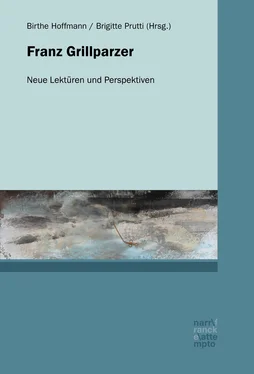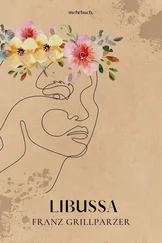Das Auge, klösterlich gesenkt, hob sich nur selten; wenn es aber aufging, traf es wie ein Wetterschlag, so grauenhaft funkelten die schwarzen Sterne aus den aschfahlen Wangen, und man fühlte sich erleichtert, wenn die breiten Lider sie wieder bedeckten. (SW 3: 120)
The unsettling intensity of the monk’s gaze shields it from legibility, and the onlookers feel themselves repelled and distanced, much like observers of an eerie night sky, as they encounter the „schwarzen Sterne.“ At the same time, the emancipation from touch and thus from proximity to and physical intimacy with strangers that a modern epistemology of sight seemed to guarantee is also negated here. Rather, the distance of the gaze is replaced with a disquieting reintroduction of proximity via an eye that seems to touch those it encounters: „Die dunklen Augen des Mönchs hoben sich bei dieser Rede [des einen Fremden] und hafteten mit einer Art grimmigen Ausdruckes auf dem Sprechenden“ (SW 3: 121 [my italics]). The unsettling combination of vision and figurative touch, of distance and proximity in the monk’s gaze is accompanied by a touch that is out of proportion to the environment to which it relates. When the Fremden suggest that a „gottgeliebter Mann“ must have built the monastery, the monk responds with a „schmetterndes Hohngelächter,“ and „[d]ie Stuhllehne, auf die er sich gestützt hatte, brach krachend zusammen“ (SW 3: 121–122). Here, touch once again conveys affect, but rather because touch turns destructive, revealing the force of barely contained rage. The breaking of the chair, a structure used to support the human frame, also foreshadows the instability of the narrative scaffolding, i.e., of the frame that will support the monk’s story.
It bears mention that the communicative situation that prompts the monk’s telling of his story is not altogether typical of the way in which Binnenerzählungen within novellas are usually set up in the frame. Whereas it frequently is the desire of the characters in the frame to be distracted from their present situation that prompts the narration of the framed narrative, in the case of Grillparzer’s novella, the Fremden actually are perfectly content to talk amongst themselves. They are engrossed „im eifrigen Gespräch; vielleicht vom Zweck ihrer Reise, offenbar von Wichtigem“ (SW 3: 120). They are not at all eager to be transported away from their usual business or from the attention they pay to each other by a tale presented to them by another party. Rather, they resist going along with the reader’s generic expectation that they will welcome the company of another person who might be expected to distract them with a story, and it is rather „ungern“ that the Fremden „unterbrechen […]“ their conversation (SW 3: 120) as the monk enters unbidden to light a fire the visitors insist they don’t need. The monk, we might say, forces his way into the discursive space to open up the possibility of the telling of what will turn out to be his confessional tale. The dual impulse of aggression and servility that marks the monk’s entry into the text will continue to characterize his behavior throughout the novella.
The monk finally begins to relate the story of the monastery’s founding, and as mentioned above, only at the closing of the narrative frame at the end of the novella will it be revealed that Starschensky, the framed story’s protagonist, is not only the monastery’s founder, but also in fact the monk. As numerous scholars of Grillparzer’s text have observed, the fact that the monk chooses not to relate a first-person narrative but rather reports about himself in the third person affords him heightened interpretive powers over the story’s characters, in particular over Elga, his/Starschensky’s love interest and, later, his wife.2 The assumption of absolute interpretive power over Elga repeats on a symbolic level the monk’s/Starschensky’s bloody murder of Elga, whom Starschensky had suspected of adultery.3 The murder represents both the climax of the monk’s/Starschensky’s story, and the culmination of the epistemological crisis at the heart of Grillparzer’s text.
Framing and Transgression
The severity of this epistemological crisis is mirrored not just in the events recounted in the monk’s story and in its murderous climax, but also in the uncontainable nature of this crisis. It is not only the case that the frame for the monk’s story is itself shot through with markers of this crisis.1 What is more, this frame cannot hold the framed story in2 – the monk’s story cannot be sublated, and the frame repeatedly cracks.3 What Henry Remak has identified as „die klassische Funktion des Rahmens“ in the novella, namely to stabilize „[das] Einmalig-Unerhörte […] der berichteten Begebenheit“ and to keep in check „[das] Sprengende […] des Inhalts“ of the narrative,4 is precisely the kind of work that the frame in Grillparzer’s text refuses to do. Georg Simmel, in his 1902 essay on the aesthetic function of the frame in painting, observed that the „Grenzen“ of a work of art mark „jene[n] unbedingetn Abschluß, der die Gleichgültigkeit und Abwehr nach außen und den vereinheitlichenden Zusammenschluß [die Einheit aus Einzelheiten im Kunstwerk] nach innen in einem Akte ausübt.“ Simmel goes on to ascribe to the frame that is added to the work of art a function that both symbolizes and enhances its existing boundary:
Was der Rahmen dem Kunstwerk leistet, ist, daß er diese Doppelfunktion seiner Grenze symbolisiert und verstärkt. Er schließt alle Umgebung und also auch den Betrachter vom Kunstwerk aus und hilft dadurch, es in die Distanz zu stellen, in der allein es ästhetisch genießbar wird.5
The possibility of aesthetic distance is what Grillparzer’s monk denies both to the two travelers listening to him and to us as readers. Early on in the framed narrative, the monk characterizes Starschensky (i.e., himself) as someone who enjoys „ein über alles gehendes Behagen am Besitz seiner selbst“ and as an individual for whom „Abwesenheit von Unlust“ is „Lust“ (SW 3: 123).6 The monk/Starschensky then interrupts the narrative and turns to his listeners: „Habt Ihr noch Wein übrig? Gebt mir einen Becher! Der Graf [Starschensky] war so schlimm nicht.“ (SW 3: 123) A short time later, immediately after he describes the looks of Elga, his future wife, the monk/Starschensky turns to his listeners, who, as he had ascertained earlier, have no relations with women, and references his sexual excitement: „Nicht wahr, davon wißt Ihr nichts, Malteser? Ja, ja, bei dem alten Mönch rappelts einmal wieder! Laßt uns noch eins trinken!“ (SW 3: 124) Here, the cracks in the boundary that was supposed to separate the framed narrative from the frame narrative force both the intra-diegetic listeners and the extra-diegetic readers into an uncomfortable intimacy with an inebriated and sexually titillated monk.7
The dialectic of „Distanz und Einheit, Antithese gegen uns und Synthese in sich”8 that Georg Simmel believes is guaranteed by the aesthetic distance a frame can provide between an artwork and its beholder is impossible to achieve in Grillparzer’s text. „[J]ene inselhafte Stellung, deren das Kunstwerk der Außenwelt gegenüber bedarf“ can only be maintained by an intact frame:
Deshalb darf der Rahmen nirgends durch seine Konfiguration eine Lücke oder Brücke bieten, an der sozusagen die Welt hinein könnte oder an der es in die Welt hinaus könnte.9
Grillparzer’s text, through its cracked frame, undercuts any possibility of aesthetic distance between listener and storyteller, between reader and narrator; and a resolution, containment, and dialectical sublation of the epistemological crisis at the text’s heart is foreclosed.
Читать дальше












